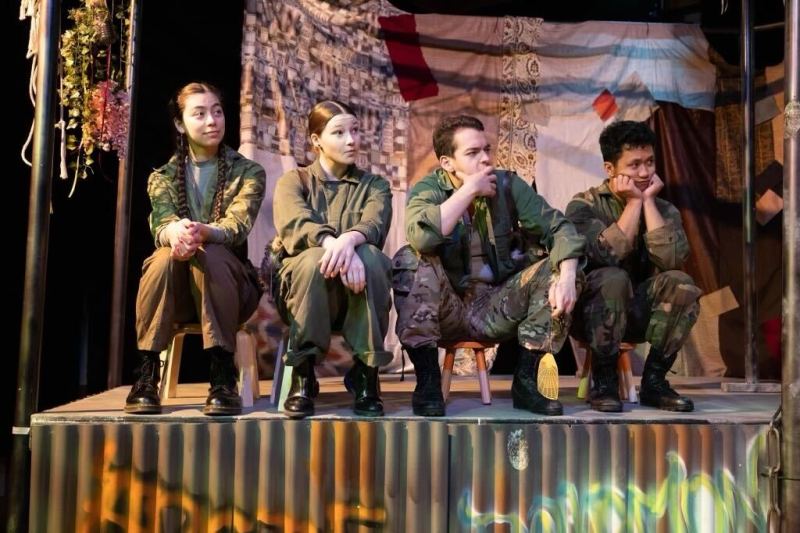Saturday’s matinee performance of “Two Noble Kinsmen” gave the classic tragicomedy a post-apocalyptic spin. The Stanford Shakespeare Company’s (StanShakes) is a student-run repertory theater company that performs creative adaptations of Shakespeare’s classical works. They change the classical settings and script content to apply to contemporary social issues.
As a Shakespeare theater lover and enthusiastic supporter of Stanford’s theater community on campus, I was eager with anticipation to attend the StanShakes show. Crew members outdid themselves with the show’s design from the costumes, lighting and set. The show had every reason to succeed under the umbrella of student theater.
When producing any Shakespeare play — especially one embellished with so much comedic potential — the director must hold a consistent vision of the play and have a deep understanding of Shakespeare’s text. The director helps actors translate the complex Shakespearean language for the audience’s understanding.
This time, though, I left the theater with mixed feelings. Oftentimes, great lines were run over by lead actors’ clumsy interpretations of the text and scenes suffered from poor blocking. I did not take away the same meaning, amusement or general enjoyment I normally do from StanShakes shows. I left with more questions about the directorial vision.
The Jacobean tragicomedy, originally published in 1634, was written through a collaboration by William Shakespeare and John Fletcher. In Act I of the play, the noble kinsmen Arcite (Varun Madan ’26) and Palamon (Ryan Dukes ’26) are jailed together and fall in love with Emilia (Katie Dimock ’25).
“This show highlights two ideas that we rarely get in Shakespeare,” said the show’s director Lexi Linker ’23 in the show’s program.
“One: the world is made livable and beautiful by the efforts of those who make it that way — efforts that are fueled by selfless and endless love for those around them. Two: evil and good are not static qualities about us, but informed by the choices, big and small, we make about how to engage with the world and those who inhabit it with us.”
The dichotomy between good and evil was salient in Act II, when Emilia cannot decide between the two noble kinsmen, so they are forced to battle. The stage combat in the fight scene was not strong, and the fake weapons bending after “blows” did not help. At times, I felt as though the comedy overshadowed the more serious moments in the play’s text. Even so, most jokes made by main characters fell flat with the audience and elicited only a few laughs.
This did provide an opportunity for supporting cast members to shine. Meredith Gavin ’26, who played the jailer’s Daughter, gave beautiful monologues grounded in her natural talent and nuanced understanding of the role. Gavin’s strong voice and sensitive approach to the character drew attention consistently. Finn Paisley ’25, who performed as the Schoolmaster, demonstrated comedic mastery with an infectious energy that had the audience roaring with laughter.
From armor made out of car plates to an intimate set adorned with leafy plants, rope and ribbons, StanShakes successfully transported the audience into this post-apocalyptic world. Colorful lighting was also expertly utilized to both darken and lighten the mood in scenes. The intentional costume design added an interesting layer to the character’s personalities. Many characters, such as Emilia and Theseus, wore military costumes and heavy black boots to indicate their higher status in the futuristic world.
“By framing Arcite and Palamon’s journey in a post-apocalyptic world, we envision seeing these characters, and those around them, fighting to build a world that is just and kind, even if the one they currently inhabit is not,” said StanShakes on their website.
At several points, though, I found myself questioning the reasoning behind this choice of setting, as I felt it didn’t add much depth to the text. There were moments in which the post-apocalyptic world lost relevance to the traditional text.
The directional intent of the show was most present at the opening, when voiceovers described an apocalyptic virus epidemic. There was no other world-building throughout the play. The sound was occasionally overpowering, taking the audience out of the play’s world. As someone who has attended StanShakes’ 2022 season productions of “King Lear” and “As You Like”, this production was not as strong.
However, I was impressed with the usage of space in this production. The Elliot Program Center, next to Lake Lagunita, acted as a black box theater in its immersive experience of the production. Due to the close nature of the space, the audience was wrapped into the post-apocalyptic world along with the actors. Our seats were only a few feet from the set; actors entered from both sides of the audience.
Overall, this performance hit the theatrical mark but didn’t exceed expectations. I am both interested and curious to see how the company approaches its spring quarter production of “Much Ado About Nothing” directed by Riley Plaut Deweese ’25.
Editor’s Note: This article is a review and includes subjective thoughts, opinions and critiques.
